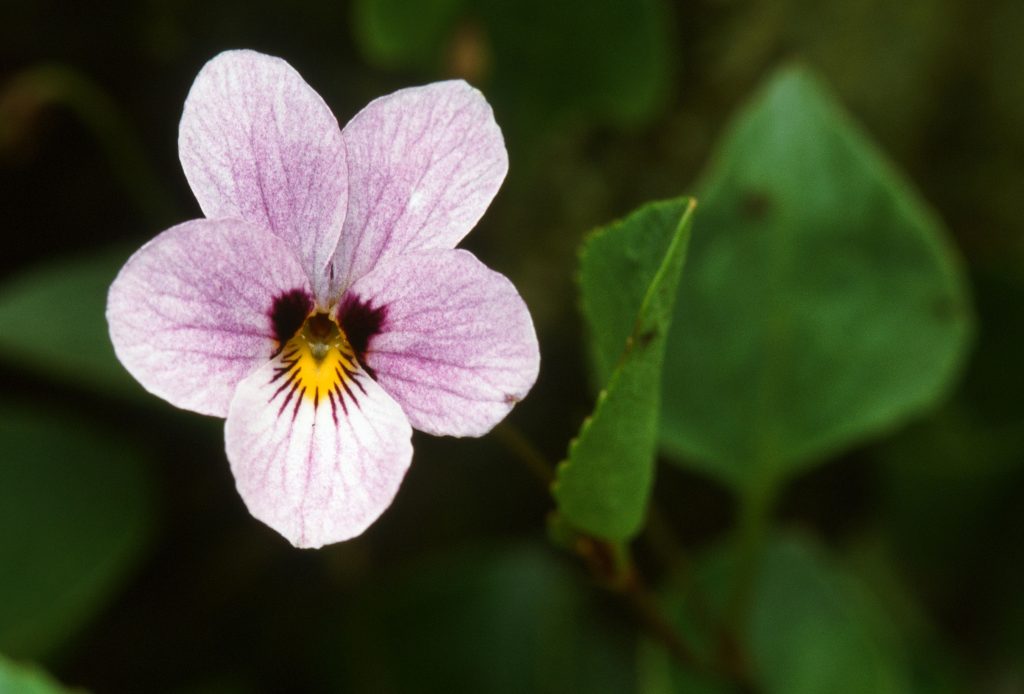Viola cuneata S. Wats.
Description. Illustrations: 4 photographs of Viola cuneata and 2 drawings.
One of a pair of very similarly flowered violet species growing in northwestern California and southwestern Oregon, Viola cuneata is narrowly localized in the Klamath-Siskiyou Range. Round, white-faced flowers have distinctive markings: a yellow central patch, relatively large, dark black-purple eyespots on the side petals and violet backs. It may be distinguished from its closest relatives, whitish flowered V. ocellata and mauve-flowered V. flettii from Washington State by its wedge-shaped (cuneate) base of the leaves. Though it is an uncommon violet species, colonies can be found in rocky serpentine or sandy loam soils in open coniferous and oak woodlands. All plants are dormant in the hot, dry summer months, reappearing after winter rains and snow to flower in March to June.

Plants are glabrous throughout, 6-25 cm high. The crown of the creeping, erect to spreading rhizome is several centimeters underground, with reddish brown roots. In the year of germination, cotyledons only will appear, in the second year basal leaves only, then in future years mature plants produce one to several erect stems. The color of stems, petioles and peduncles can be green, pink or purple.

Both basal and cauline leaves are smooth, thicker texture than V. ocellata and all standing vertically. The conspicuously translucent leaf veins may be green, pink or purple. All leaf bases taper into the petiole (cuneate) with the green margin of the lamina continuing down the edges (decurrent), leaf margins crenate. As usual, the basal leaves are larger than the stem-leaves, on longer petioles; basal leaves are round-ovate to wide ovate or deltoid, barely acute at the apex, or truncate. Cauline leaves are deltoid to rhomboid in shape, acute at their apex. The stipules on basal leaves are ovate, scarious, 4.5 long; cauline stipules green plus some purple, 2.2 mm long, both with glandular-tipped fimbriae on the margin and not adnate to the petiole. Bracteoles on the peduncle are close to the flower at the top, green to purple, 2.0-2.5 mm long.

Flowers, produced from the axils of, and above, the upper stem leaves are 1.6-2.1 x 1.7- 2.3 cm wide. Flower petals are white on their inside but can age to pale mauve, the three lower petals with yellow at the base and all veined with purple or pink-purple guidelines. All petals are darkly purple, red-violet or even pink on the back that can show through the petals. The inside surface of the upper two petals may be purplish at the base; lateral petals have very short, clavate, colorless hairs at the throat. The lowest petal end is truncate to slightly emarginate, but looks pointed when it is folded down the middle. The petal spur is pale green to yellow-green, 1.0 mm long x 2.5 mm wide. The stigmatic head is indented, and with hairs on back and sides of head. Rarely there is an all-white flowered plant, or one with pink marking instead of dark purple. The calyx is 4.5 mm long; sepals tapered, green with purple, purple midline, tip blunt with an obvious terminal gland; appendages rounded, thick.

Seed pods are axillary, round, trigonous, 5–8.5 mm, with short flaring to recurved sepals, both capsule and sepals green to purple. Seeds dark brown to black, 2.3-2.7 x 1.5 mm.

V. cuneata grows in serpentine soil and in well-drained clay to sandy loams, in full sun to part shade, often near V. adunca, V. hallii and V. lobata. Few plant species adapt to life in the harsh soils derived from serpentinite rocks, rich in heavy metals (magnesium, iron, chromium and nickel). Calcium is also so tightly bonded that it is unavailable. These red-rock areas of apparent semi-desert are scattered throughout the ancient Klamath Mountains and are easily visible because the rock weathers to an impoverished orange soil. They are sparsely populated with distinctively poor vegetation, greyish dwarf trees, sparse yellow bunch grasses and vivid wildflowers. Winter precipitation is high, partly as snow. Little springs and seeps provide good water supply to the fine clay soil during spring. The serpentine area trees are slow-growing: Arbutus menziesii (madrone), Arctostaphylos viscida (manzanita), Pinus jeffreyi (Jeffrey pine) and Libocedrus decurrens (dwarfed incense cedars) and Quercus garryana (oak). Non-serpentine habitats of V. cuneata are slightly acid to neutral sandy or clay loam with Arctostaphylos patula, Pinus ponderosa (yellow pine), Pseudotsuga menziesii (Douglas fir), Quercus kelloggii.
Range: Northwestern California: Del Norte, Humboldt, Mendocino, Shasta, Siskiyou & Trinity Counties. Southwestern Oregon: Josephine Co.
Elevation: 600–2200 m, a higher altitude range than V. ocellata.
Nomenclature and Taxonomy:
V. cuneata S. Watson
Proc. Am. Acad. 14: 290, 1879.
Section Chamaemelanium Becker, subsection Canadenses (Marcussen, 2011).
V. cuneata is a diploid species, 2n=2x=12, where x is the base chromosome number.
First collected by Volney Rattan in June, 1878, south of the Trinity River, Humboldt Co. California, and described by Watson. It is closely related to V. ocellata and to V. flettii, and may be considered the connecting link between them.
Molecular data have put the narrowly distributed western US endemics together in one small group at the base of the evolutionary tree of subsection Canadenses, suggesting a western coastal or near-coastal ancestor (Ballard, 1999).